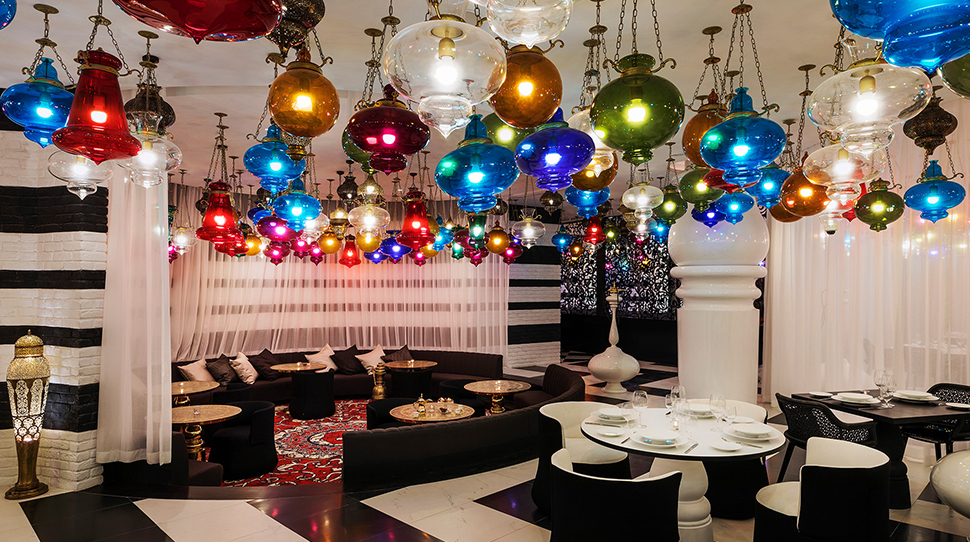

Like its multicultural population, Doha has a diverse foodie scene. But epicureans should not miss a chance to sample traditional Qatari cuisine.
Reflecting regional influences from Iran, India, the Levant, North Africa and Asia, classic dishes highlight the city’s history as a fishing and pearling port. Plates are designed to be shared communally and meals are hearty, a product of the country’s desert origins.
While Qatari dishes can be found in restaurants across the city, the best place to start is in Doha’s beating heart, Souq Waqif. Follow our guide to taste your way across the classic culinary scene at the popular market and other tasty corners of the city.
On the edge of Souq Waqif, this humble café has attracted residents, royalty and even the occasional Hollywood celebrity — actress Tilda Swinton stopped by for a bite last summer. Run by the venerable Shams Al Qassabi, this unassuming spot churns out homestyle Qatari food, served without adornment or fanfare.
One of the specialties here is ragag, paper-thin flatbread that comes with fresh cheese, honey or accompanying a stew or curry.
Another must-order is balaleet, a Qatari sweet/savory dish of vermicelli flavored with sugar, cardamom, rose water and saffron that’s topped with an omelet. Sweet, salty and crunchy, this local favorite can be eaten for breakfast or as a dessert.
Al Jasra Traditional Food
Tucked in a quiet alley in Souq Waqif, this quaint eatery is run by a group of Qatari women who prepare the day’s offerings based on produce found at the surrounding market. The menu may be small, but plates are big on flavor and potential social media excitement, too — dishes are presented on colorful enamel tableware like those used in many Qatari homes.
Menu standouts include a version of chicken biryani (an aromatic rice dish) using Indian and Arabic spices, and a fiery take on scrambled eggs.
But it’s the luqaimat that are not to be missed. These bite-sized sweet dumplings (like doughnut holes) are deep-fried and dunked in sugar syrup. Usually, honey and, less frequently, nuts also are added to enhance the taste and texture of the dish.
Still in the vicinity of Souq Waqif is this regional gem. While the restaurant is essentially Yemeni, its menu focuses on Qatari and Gulf (Khaleeji) favorites, too.
Opt for a traditional experience by dining off of a plastic sheet on the floor. You also can be seated at a table, but then you’d miss out on the communal fun.
Highlights include oven-baked, locally caught fish, and saloona, Qatari-style stew packed with tender slow-cooked lamb and vegetables, spiced with a hint of chili and served on a bed of rice. Soak up the sauce with huge discs of oven-fresh flatbread delivered hot to your dining space.
The interiors of this whimsical dining room within the delightfully eccentric Mondrian Doha may seem like an Arabian Nights fantasy — ornate colored lanterns suspend from the ceiling and billowing curtains divide the black-and-white dining room — but the menu is pleasantly grounded.
This is a great place to try renditions of some of Qatar’s beloved dishes, such as lamb harees (coarsely ground wheat mixed with meat and seasoned with onion, garlic and cinnamon) and chicken madhrooba, a red lentil porridge.
Walima’s take on lamb machboos — the meat is slow-cooked with richly spiced rice and topped with nuts and fruit — is also highly regarded.
Karak Mqanes
With a dozen Doha locations (and more to come), this simple tea stop pays homage to Qatar’s rich falconry history by specializing in karak, a sweet, spiced Indian tea typically enjoyed around a fire after a hunt.
Order your sip in a small cup or a dallah (ornate coffee pot) for sharing and enhance it with extras like saffron or ginger.
Pair your brew with a japati (chapati) or buri (puri) flatbread stuffed with cheese, spicy scrambled eggs or Nutella for a sugar hit.
Sitting inside the iconic National Museum of Qatar, this sleek spot is run by lauded local chefNouf Al Marri. Not your usual museum café, this place offers an accessible yet creative glimpse into Qatari cuisine.
Dishes range from simple chapati flatbreads filled with cheese or honey to the Qatari version of shakshouka (eggs poached in spicy tomato sauce). The café’s take on aseeda (a sweet dish made with cooked wheat flour sometimes topped with butter or honey) sees the unusual addition of silky pumpkin puree. Like the rest of the museum, the eatery features stunning design touches, like handmade plates and flatware, and quartz desert roses adorning each table.
